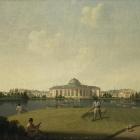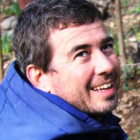Though scholars have recently turned their attention to the politics of cultural landscapes, they largely continue to neglect the importance of trees in this statecraft. Politicians, however, do not. In fact, trees in the largest park in St. Petersburg’s historic downtown—Tavrichesky Garden—recently took part in Putin’s most important public memory project: immortalizing the patriotic narrative of Russia’s victory in World War II. A closer examination of the trees of this park reveals them to be intrinsic actors, both past and present, in the political use of landscape.
In 1703, Peter the Great wanted the gardens of his new capital, St. Petersburg—Russia’s “window to Europe”—to resemble the gardens of the courts of Western Europe which were used to enhance political and social status. European spruce (Picea albies), Scots pine (Pinus sylvestris), and birch trees (Betula spp.) naturally dominated the area where he later built his city. But Peter imported deciduous trees (e.g., oak, linden, maple, and elm) which resembled those found in Western European gardens, which he considered more “cheerful.” Fast-forward nine decades and “European” vegetation had replaced most of the area’s original greenery. Catherine the Great continued Peter’s Europeanization policies. And when Prince Potemkin, her most influential advisor (and lover), built Tavrichesky Garden adjoining his new palace in St. Petersburg, he hired Englishman William Gould to design the park in the English landscape style. At its heart was a manmade pond, canals, and islands surrounded by hilled embankments and thousands of newly planted trees—the descendants of Peter’s “European” trees. Thus, from its inception, the greenery of the park promoted the political visions of its founders.
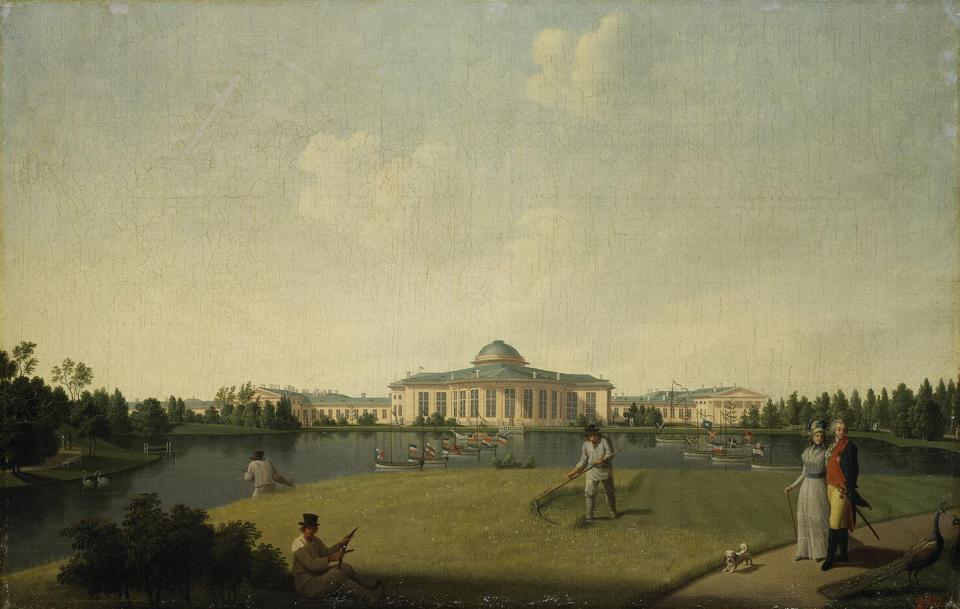
Painting, dated 1797, by Swedish artist Benjamin Patersen: “View of the Tauride Palace from the Garden Side”
Painting, dated 1797, by Swedish artist Benjamin Patersen: “View of the Tauride Palace from the Garden Side”
Accessed via Wikimedia on 13 August 2020.
Click here to view source.
 This work is licensed under a Creative Commons Public Domain Mark 1.0 License.
This work is licensed under a Creative Commons Public Domain Mark 1.0 License.
In the 1860s the Gardens were first opened to the public. By the Revolution of 1917, their landscape had changed decidedly as the park was partitioned into various sections run by an odd mix of state-supported voluntary associations and for-profit ventures, reflecting the economic and social development of the capital city in the late Tsarist period.
In the early Soviet period, the park’s vegetation remained largely untouched. However, the 900-day Siege of Leningrad during World War II left millions of dead and wounded. Popular histories record Tavrichesky’s trees as victims of the Nazi air raids and artillery bombardments. During the War, the Soviet government renewed Tsarist motifs of Russian nationalism in its identity politics. The State’s intensive efforts to undo German destruction and perfectly restore historic monuments, including landscape gardens, played a significant role in these new politics. After the War, Tavrichesky’s vegetation played an important part in the work of “restoration” of the park to its “pre-Revolutionary condition.”
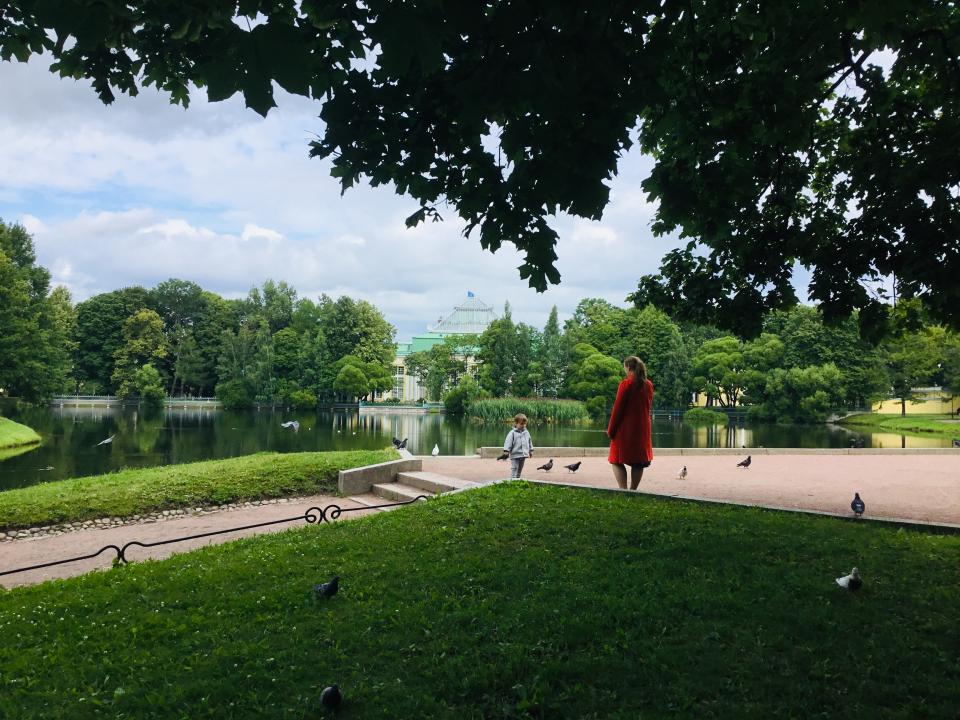
Current-day photograph of the same place in the park that Benjamin Patersen painted over 200 years ago.
Current-day photograph of the same place in the park that Benjamin Patersen painted over 200 years ago.
Photograph by Lewis Purcell.
 This work is licensed under a Creative Commons Attribution 4.0 International License.
This work is licensed under a Creative Commons Attribution 4.0 International License.
In 1972 the vegetation found a new way to participate in statecraft. That year, to commemorate their jubilee, the Young Pioneers (the primary children’s organization of the Soviet Union) planted an avenue of 50 young oaks called the “Allée of 50-years of Pioneering.” They placed an exhibit adjacent to each tree that told of the Pioneers’ history and achievements. Even after the commemorative events, these trees stood as monumental markers to this celebration. Importantly, the 1970s represented a new page in the USSR’s environmentalism. At this time, articles about Lenin’s love of nature appeared throughout the nation’s newspapers, and socialism was promoted as being inherently more conservationist than capitalism. Thus, the Pioneers’ oaks can be seen as proudly socialist, too.
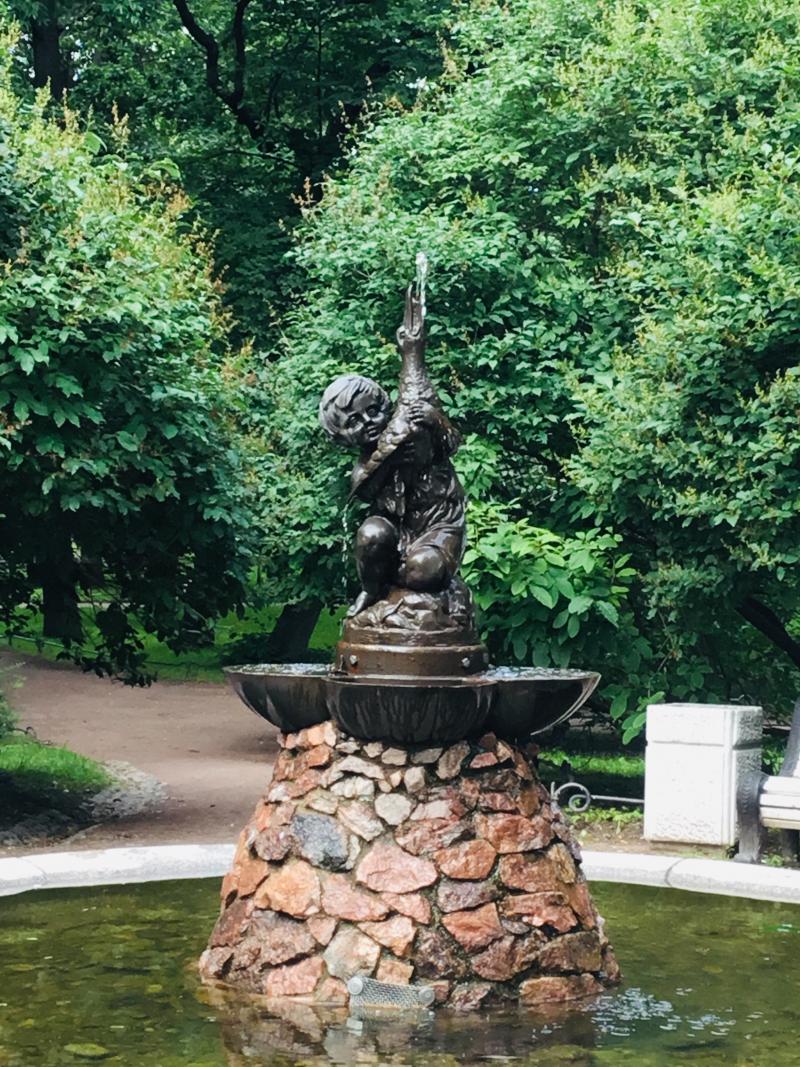
Photograph of the fountain “Boy with a Duck.” The original was installed in Tavrichesky Garden in 1910, later moved, and then returned to its original home as part of the “restorative nostalgia” restoration of 2003.
Photograph of the fountain “Boy with a Duck.” The original was installed in Tavrichesky Garden in 1910, later moved, and then returned to its original home as part of the “restorative nostalgia” restoration of 2003.
Photograph by Lewis Purcell.
 This work is licensed under a Creative Commons Attribution 4.0 International License.
This work is licensed under a Creative Commons Attribution 4.0 International License.
Fewer than two decades later, social, political, and economic upheaval roiled the country. The park’s greenery suffered as much as the general population. Luckily for the trees, the city government, stimulated by financial and logistical aid from the government of Denmark, repaired the park just in time for the city’s 300th birthday. They worked to meticulously “restore” the park to its “golden era” at the turn of the previous century, by practicing “restorative nostalgia”: a post-Soviet practice of indiscriminately replicating nineteenth-century forms in the early twenty-first century. It sprung from a nostalgic yearning among Russia’s political elite for positive historical narratives to replace the pessimistic narratives that dominated Yeltsin’s Russia. The restoration of the garden in 2003 included the planting of hundreds of trees—elms, oaks, linden, ash, maples, and birch—and thousands of other bushes. To conclude the restoration, national and international politicians gathered to plant another allée. A high-ranking federal official spoke before the event. He declared: “We will plant trees tying together into one the past, the present, and the future.” These newly-planted trees represented the state’s newly-proposed vision of the past.

Photograph of the commemorative plaque marking the planting of 70 trees and bushes to mark the 70-year anniversary of victory over Nazi Germany in the Great Patriotic War.
Photograph of the commemorative plaque marking the planting of 70 trees and bushes to mark the 70-year anniversary of victory over Nazi Germany in the Great Patriotic War.
Photograph by Lewis Purcell.
 This work is licensed under a Creative Commons Attribution 4.0 International License.
This work is licensed under a Creative Commons Attribution 4.0 International License.
The trees of Tavrichesky continue to march through history as important actors in cultural landscapes. During the last decade, bureaucrats planted three new avenues of trees in Tavrichesky, each with their own plaque. One reads: “In commemoration of the 70-year Anniversary of the Great Patriotic War 1941–1945.” Putin’s state thus tries to identify these lindens and lilacs with its most important public memory initiative: monumentalizing heroic narratives of World War II. The greenery of St. Petersburg’s Tavrichesky Garden is part of Russia’s political and social history. The trees and vegetation of urban parks are actors in their own right and deserve a page in the history books.
How to cite
Purcell, Lewis. “The Trees of Tavrichesky Garden: Forgotten Actors in the Politics of Cultural Landscape.” Environment & Society Portal, Arcadia (Summer 2020), no. 31. Rachel Carson Center for Environment and Society. https://doi.org/10.5282/rcc/9099.
ISSN 2199-3408
Environment & Society Portal, Arcadia
 This work is licensed under a Creative Commons Attribution 4.0 International License.
This work is licensed under a Creative Commons Attribution 4.0 International License.
2020 Lewis Purcell
This refers only to the text and does not include any image rights.
Please click on the images to view their individual rights status.
- Brain, Stephen. “The Environmental History of the Soviet Union.” In A Companion to Global Environmental History, edited J. R. McNeill and Erin Stewart Mauldin, 222–43. Chichester, UK: John Wiley & Sons, Ltd., 2012. doi:10.1002/9781118279519.
- Haskins, Ekaterina V. “Russia’s Postcommunist Past: The Cathedral of Christ the Savior and the Reimagining of National Identity.” History and Memory 21, no. 1 (2009): 25–62. doi:10.2979/his.2009.21.1.25.
- Hunt, John D., and Peter Willis. The Genius of the Place: The English Landscape Garden, 1620–1820. Cambridge and London: Massachusetts Institute of Technology Press, 1988.
- Ignatieva, Maria, Galina Konechnaya, and Glenn Stewart. “St. Petersburg.” In Plants and Habitats of European Cities, edited by Norbert Müller and John G. Kelcey, 407–52. New York: Springer, 2011. doi:10.1007/978-0-387-89684-7_12.
- Light, Duncan, and Craig Young. “Political Identity, Public Memory and Urban Space: A Case Study of Parcul Carol I, Bucharest from 1906 to the Present.” Europe-Asia Studies 62, no. 9 (2010): 1453–78. doi:10.1080/09668136.2010.515792.
- Nilsson, Kjell, Ulrika Åkerlund, Cecil C. Konijnendijk, et al. “Implementing Urban Greening Aid Projects—The Case of St. Petersburg, Russia.” Urban Forestry & Urban Greening 6, no. 2 (2007): 93–101. doi:10.1016/j.ufug.2007.01.004.
- Ponomarev, I. A. "Tavricheskiĭ Sad." Istorii͡a Peterburga 3, no. 13 (2003): 32–39.



